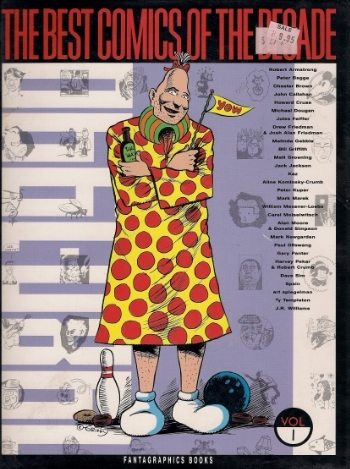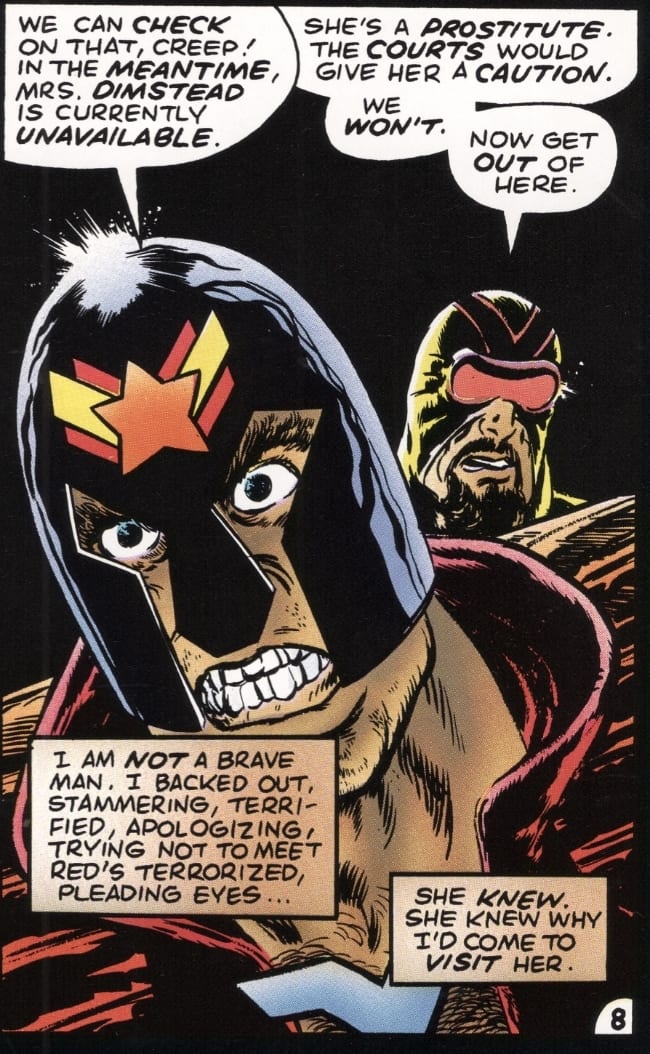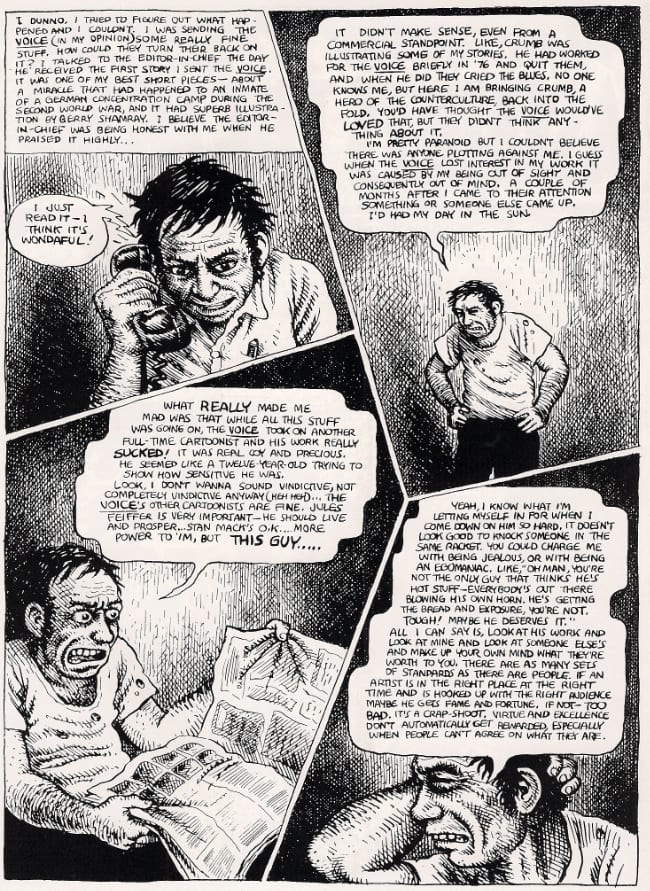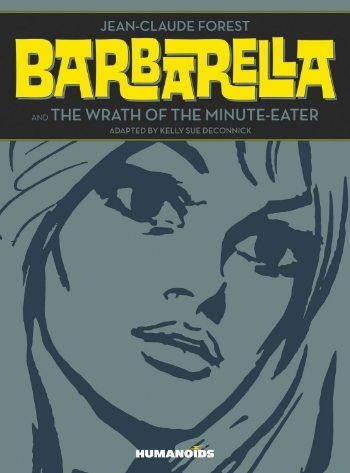 Yesterday, Guardian columnist Jonathan Jones lamented the “studied banality” of contemporary graphic novels, declaring the ranks of bookshelves -- one presumes those of generalist booksellers, which immediately introduces unacknowledged economic factors into the mix -- redolent with “variations on a reductive graphic style designed to communicate information and signify simple emotions, but never to take the risk of showing a genuinely new, genuinely personal and daring perception of reality.” Some consternation erupted online, fueled by Jones' favorable citations to such age-old fan favorites (by which I mean “favorites of age-old fans”) as Robert Crumb and Alan Moore, the latter amusingly invoked without reference to any of the collaborators who'd actually draw 'his' comics, although I suppose we could be dealing with a Maxwell the Magic Cat fanatic.
Yesterday, Guardian columnist Jonathan Jones lamented the “studied banality” of contemporary graphic novels, declaring the ranks of bookshelves -- one presumes those of generalist booksellers, which immediately introduces unacknowledged economic factors into the mix -- redolent with “variations on a reductive graphic style designed to communicate information and signify simple emotions, but never to take the risk of showing a genuinely new, genuinely personal and daring perception of reality.” Some consternation erupted online, fueled by Jones' favorable citations to such age-old fan favorites (by which I mean “favorites of age-old fans”) as Robert Crumb and Alan Moore, the latter amusingly invoked without reference to any of the collaborators who'd actually draw 'his' comics, although I suppose we could be dealing with a Maxwell the Magic Cat fanatic.
Me, I could only chuckle. I'd just slapped down ten bucks for the item on your left, the first of two 1990 hardcover anthologies, their contents “[s]elected by the editors of The Comics Journal” (i.e. Gary Groth, Kim Thompson & Robert Boyd) - and wouldn't you know it, the heart of Jones' argument is affirmed by Messrs. Groth & Thompson in their opening editorial, celebrating “serious, dedicated artists whose single imperative was to express an uncompromising, personal vision.” Jones merely presses harder on the visual element as the core of said vision: “A real comic artist is someone who uses drawing as self-expression instead of as a narrative machine.” But Groth & Thompson also anticipate Jones' critical error - viewing 'graphic novels' as a simple genre of novels, which limits the possibilities of the art to what book publishers deem salable. “The best comics in the '80s were scattered throughout a handful of formats and media,” note Groth & Thompson, referencing the contemporaneous scrum of magazines, periodicals and low print run comic books vs. the more popular franchise titles; just as 'comics' then were not only the wares of DC and Marvel, so too should “the comic-book universe,” per the Guardian headline, not be encircled by a newer commercial fence.
Which begs the question: what sort of comics did the Journal editors favor those many decades ago? Do these older cartoonists put “meaning and feeling into each line,” as Jones demands? Indulge me this selection of five interesting panels.
--
1. "How Can I Write A Story About Fashion, Now That My Toy Boy Is Gone?" - Melinda Gebbie (from Wimmen's Comix #11, 1987)
Naturally, a personal and daring perception of reality is itself the communication of information, and I don't feel an emphasis on the former needs circumvent the narrative values of the latter. Take this drawing by Gebbie, a veteran of several underground anthologies, whose entire story is a riot of conflicting signals: images range from scribbled studies of messy beds to stippled realist faces, with dialogue often recounted via phonetic dialect, to better evoke the artist's experience as a US expat in the UK. It's an account of a prolonged fling, with the above panel serving as climax - having been left by her gormless lover for basically no reason, Gebbie immortalizes him in an erotic/grotesque tableaux set within the yet-more grotesque tableaux that is the scene itself. You will be forgiven for confusing the actual ex-lover and his irate family (on the left) with those on the canvas (to the right, note the dotted background); Gebbie puts both planes of existence into parity as a means of demonstrating her emotional distance from one and her artistic detachment from the other, both contra the detail with which a very satisfied Melinda Gebbie herself is drawn. In this way, Gebbie's perception of the scene is communicated by dint of drawing; it's not just a depiction of a subjective point of view, but a summary of the story's interpersonal conflict, as well as the culmination of the heroine's character arc. Gebbie is well-suited to a collection like this, as she's only ever released one solo comic: 1977's Fresca Zizis, which can still be ordered from her fellow underground survivors at Last Gasp.
--
2. "Daily Strip" - Bill Griffith (from Weirdo #24, 1989)
This one reminds me of the time the Canadian cartoonist Seth observed that Bill Watterson's works "didn’t mean anything to me" during an interview at the AV Club; from some of the reactions in the comments you'd swear he'd burned the American flag. And yet Watterson commands great institutional respect as a classicist, a quality entertainer - and who's to say Bill Griffith hews to the same opinions he had 26 years ago? Still, I'm pretty delighted with "chortling softly," an utterly perfect backhanded assumption as to how the romping sentimentality of Calvin and Hobbes is probably received, from the perspective of someone who doesn't *really* care but has wriggled just far enough through the door to scope out the room. Griffith narrates his estrangement from mainstream expectations cleanly and with little fuss, as you'd expect from the creator of a successful newspaper strip who can work the mechanics pretty good but knows damn well that his particular interests will keep him away from too much of the cultural penetration that both tantalizes and disgusts him. The quintessential ambivalence of the alternative comics generation, age and career trajectory notwithstanding.
--
3. "In Pictopia!" - Alan Moore, Donald Simpson, Peter Poplaski, Mike Kazaleh & Eric Vincent (from Anything Goes! #2, 1986)
Groth & Thompson also declare genre fiction "intrinsically inferior to work of a more personal nature" - which needn't foreclose on a more comics-centered ambivalence. Flash of lightning! Peal of thunder! ENTER: Alan Moore! Of anything on this page, you've most likely heard of "In Pictopia!" - it holds a special place in the Moore catalog, pairing him with a crew of Kitchen Sink Press regulars to parody both the domination of superhero comics on the popular funnybook landscape, as well as the darkening of superheroes themselves. Given that Moore & Dave Gibbons were not halfway through their inescapable Watchmen at the time, there is also a distinct element of confession. This panel, I think, is the lodestone. I mean, why is the dark, nasty, cruel modern superhero in the foreground Judge Dredd, who'd been a going concern since 1977? I think it's not really Dredd, but what he represents: the spread of talent out of rougher forums like 2000 AD, and into the heartland of pop comics. Standing behind Dredd is Vigilante, an increasingly violent ski-masked revival of an old cowboy hero which Moore had scripted for two issues the year prior; clearly this writer's hands are not clean, and he is staring at the blood wondering if all the sorting of entrails he's done has really accomplished much of anything. But it wasn't too far into the '90s that Moore's self-publishing ventures failed and he was collaborating with a lot of the tougher superhero guys who'd split to form Image - that's commerce.
--
4. "Cynicism" - Paul Ollswang (from Prime Cuts #7, 1988)
Let's get back to drawing. Personal visions don't get much more personal than those of Paul Ollswang, an Oregon cartoonist whose works all but hummed with diverse and archaic influences. His story is a comics biography of the Greek philosopher Diogenes of Sinope, best known early adherent of the Cynic philosophy, but it's not at all like the educational comics you'll find on most bookshelves right now - Ollswang instead sharply divides his words and pictures in a manner less reminiscent of RAW than Punch, leaning heavily on detailed caricature and minutely assembled calligraphy. Try to read those words, however (or just read the whole story here) - the humor doesn't just come from his subject, but his narrative disposition, flouting the authority of his sources to substitute more interesting avenues for drawing. It's like a vaudeville lecture, a chalk talk far too laborious to be performed live, but somehow carrying the sense of reckless improvisation. Ollswang did two issues of a series titled Dreams of a Dog (1990-91) at Rip Off Press, and the magnificent one-off SF satire Doofer: Pathway to McEarth (1992) with Taft Chatham & James Carpenter at Fantagraphics. He died in 1996.
--
5. "American Splendor Assaults the Media" - Harvey Pekar & Robert Crumb (from American Splendor #8, 1983)
There's more than one way to lecture, though. You could always just put word after word in a big, fat bubble up over your narrating head. Now that I look at it, maybe a single panel doesn't do this justice. Let me expand this to a whole page:
Every page is like this, all four of them - all of them comprised of nothing but Harvey Pekar talking, sometimes positioned in the past, sometimes barking from the present (these are the bits with the undershirts with holes). Occasionally another character appears in the panel, like a second actor walking briefly onto the stage, but often you're only seeing Pekar, courtesy of the famous draughtsman Robert Crumb, who does a pretty good job of spacing all of these images so they don't simply suffocate from the verbiage. This is not typically how you make for a comic, although I can think of reasons why you'd include it in a book like this: it's a writer talking intimately about rather mundane business concerns, which (Bill Griffith supra aside) was certainly not so common a thing to see in a comic itself, particularly given the legacy of exploitative business practices in the commercial sectors of the industry; and it's also, by its unusual makeup, sort of an argument that comics can, in fact, be whatever sort of vision or communication you desire, even if you suspect the ideal medium for such work may now be Facebook. Pekar even states his rationale at the close of the story: "That's about what I can do when things bother me - write stories about them..."
And anyway, if you don't like the text, I guess you can always disassociate Crumb's drawings or something. "Fourteen Views on Harvey Pekar's Face" - hang it in a gallery, it's art!
***
PLEASE NOTE: What follows is not a series of capsule reviews but an annotated selection of items listed by Diamond Comic Distributors for release to comic book retailers in North America on the particular Wednesday identified in the column title above. Be aware that some of these comics may be published by Fantagraphics Books, the entity which also administers the posting of this column. Not every listed item will necessarily arrive at every comic book retailer, in that some items may be delayed and ordered quantities will vary. I have in all likelihood not read any of the comics listed below, in that they are not yet released as of the writing of this column, nor will I necessarily read or purchase every item identified; THIS WEEK IN COMICS! reflects only what I find to be potentially interesting.
***
SPOTLIGHT PICKS!
Yo, Miss: A Graphic Look at High School: Lisa Wilde has been putting together small zines fictionalizing her experiences teaching at a "second chance" high school in Brooklyn for a little while, and this 160-page, 6" x 9" Microcosm edition looks to be a collection of everything. I'm totally unfamiliar with the work, but it's being distributed via Diamond now, and the official site has many samples to sift through; $14.95.
Barbarella and the Wrath of the Minute-Eater: Both a reissue and a continuation of Humanoids' effort at returning Jean-Claude Forest's trend-setting space strip to print, insofar as the original 1964 album is now being paired with its 1974 sequel in an 8.5" x 11" hardcover, 152 pages in total. The art also appears to be in b&w, as opposed to the duotone of the publisher's much larger deluxe edition of just the '64 stuff from last year. Forest wrote and drew a third Barbarella album in '77 (this is the one Heavy Metal translated as Barbarella: The Moon Child), then collaborated with artist Daniel Billon on a fourth in '82. As before, the English adaptation is by Kelly Sue DeConnick. Samples; $34.95.
--
PLUS!
The Walking Man: 10th Anniversary Edition: Okay, I think I'm on the right footing here, but - if I'm reading the Fanfare/Ponont Mon catalog correctly, this is basically a reissue of the publishers' earlier English translation of Jirō Taniguchi's early '90s classic of not a damn thing happening - it's just an average man taking a series of walks, albeit drawn with the crystal-clear cartoon realist precision of a post-Ōtomo seinen epic that nonetheless steadfastly refuses to start a plot. It's fantastic, although be aware that Taniguchi later added about 100 pages of stuff to a 2010 edition which just saw French translation via Casterman. I *think* this expanded version is also going to be released in English at some point, although it is not the edition available here; $25.00.
Ariol Vol. 6: A Nasty Cat (&) The Cisco Kid Volume 2: 1953-1956: Two continuing efforts, both in and of themselves and as parts of individual publishing missions. Ariol is NBM/Papercutz, presenting both domestic and European kids comics in translation, here from Emmanuel Guibert & Marc Boutavant. The Cisco Kid is the latest softcover from the well-regarded Classic Comics Press, packaging 232 pages of cowboy daily strips from Argentinian artist José Luis Salinas, collaborating with writer Rod Reed. An introduction by Don McGregor is also promised; $12.99 (Ariol), $24.95 (Cisco).
Mandrake the Magician #1: The protagonist of In Pictopia!, incidentally, was a parodic variant on Lee Falk's early syndicated adventure strip hero Mandrake the Magician. I can only presume Dynamite is being a bit more straightforward in its new effort at reviving various King Features characters, and this one is of particular interest due to the presence of writer Roger Langridge, who tends to bring a strong sense of personality to licensed series such as this. The artist is Jeremy Treece. Preview; $3.99.
The Multiversity: Mastermen: Being writer Grant Morrison's latest alternate dimension superhero frolic, this time working with penciller Jim Lee and inker Scott Williams, who basically set down the plans for how a a good number of artists work the superhero aesthetic - interesting that they're tasked here with detailing a world in which Nazi rule has transitioned into a seeming utopia, possibly stemming from Hitler's reading too many comic books and formulating a means by which to make his superhero ideals dominant. Can a scrappy grip of Quality Comics acquisitions inspire a more righteous praxis? There's two more of these to come, including a 'real world' issue with Doug Mahnke and a concluding bookend with Ivan Reis & Joe Prado of The Multiversity #1. Preview; $4.99.
Dark Horse Presents #7: You know what else old souls love? Legacy numbering. Dark Horse is certainly aware of the appeal, as it has made sure to note that its on-and-off house anthology has now reached issue #200 in aggregate, which is why this particular issue is 80 pages in length. Among the promised features is a piece from Gone Girl author Gillian Flynn, teaming with no less a pro than UK comics laureate Dave Gibbons - I'm presuming it's a print version of their webcomic from last year. There's also original stuff from reliable series like Hellboy and Groo, among other new and continuing works. Samples; $4.99.
Plunder #1 (&) Ei8ht #1: Finally, I'll list a pair of new comic book debuts, since it's not an overwhelmingly crowded week. Plunder is technically a BOOM! release, although it's under the auspices of Archaia, which specialized in visually lavish genre comics for much of its independent period. It's about modern piracy and terror on the high seas. The artist is the Philadelphia-based Skuds McKinley, and the writer is one Jonathan "Swifty" Lang. Ei8ht, meanwhile, is I think a retitled Dark Horse print edition of an adventuresome SF webcomic from Brazilian artist Rafael Albuquerque, who's worked on some mainline American comics projects like American Vampire with Scott Snyder. Here he's joined by co-writer Mike Johnson. Plunder preview, Ei8ht preview; $3.99 (Plunder), $3.50 (Ei8ht).














